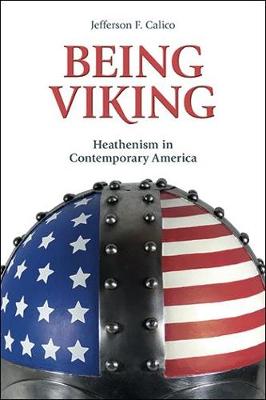Contemporary and Historical Paganism
1 total work
Contemporary Paganism has been a growing segment of American religiosity for over forty years and is composed of a variety of groups, practices, and ideologies. Asatru (Asatru), a movement that seeks to revive the practice of pre-Christian Norse religion, remains one of the least studied of these Pagan movements despite its growing prominence in the Pagan community.
Being Viking provides a rigorous ethnographic account of the Asatru religion in America, also known as Heathenry or Heathenism. Arising from five years of original ethnographic fieldwork among American Asatru adherents, the book expands our understanding of this religious movement by providing a comprehensive analysis as part of the American religious context. Asatru is a reconstructionist form of contemporary Paganism, deriving its sacred stories, polytheism, and religious culture from an interaction with the ancient Paganisms of pre-Christian northwestern Europe. Yet, contemporary tributaries shape the movement's reception of the past and its enactment of the ideas and practices discovered there. American Asatru encompasses a diversity of approaches and offers a distinctive counterpoint to some of the characteristic patterns of religious life found in other forms of contemporary Paganism. Being Viking examines the complex interaction of new and old that influences Asatru symbolism, spirituality, and social organization.
In addition to describing its rich religious ideology, Being Viking sets the movement within the context of contemporary American culture. Scholars have recognized that new religions offer alternative solutions to the felt tensions of society. Using this paradigm, Asatru is seen as a movement that provides creative religious solutions to the tensions experienced by modern Americans. This study addresses several of those points, including the socially isolating effects of modernity, women's roles, epistemology, and human relationships with nature. Asatru draws on ancient Norse ideas and practices to create new modes of living in the modern world that seek to create meaning and deepen the lived experience of its contemporary adherents. Asatru is in the process of emerging as a viable and complex religion that achieves a degree of cultural continuity by reinvigorating certain American values. In this light, Asatru is a new American religion that incorporates and adapts important cultural values while at the same time challenging some scholarly assumptions about new religions.
Being Viking provides a rigorous ethnographic account of the Asatru religion in America, also known as Heathenry or Heathenism. Arising from five years of original ethnographic fieldwork among American Asatru adherents, the book expands our understanding of this religious movement by providing a comprehensive analysis as part of the American religious context. Asatru is a reconstructionist form of contemporary Paganism, deriving its sacred stories, polytheism, and religious culture from an interaction with the ancient Paganisms of pre-Christian northwestern Europe. Yet, contemporary tributaries shape the movement's reception of the past and its enactment of the ideas and practices discovered there. American Asatru encompasses a diversity of approaches and offers a distinctive counterpoint to some of the characteristic patterns of religious life found in other forms of contemporary Paganism. Being Viking examines the complex interaction of new and old that influences Asatru symbolism, spirituality, and social organization.
In addition to describing its rich religious ideology, Being Viking sets the movement within the context of contemporary American culture. Scholars have recognized that new religions offer alternative solutions to the felt tensions of society. Using this paradigm, Asatru is seen as a movement that provides creative religious solutions to the tensions experienced by modern Americans. This study addresses several of those points, including the socially isolating effects of modernity, women's roles, epistemology, and human relationships with nature. Asatru draws on ancient Norse ideas and practices to create new modes of living in the modern world that seek to create meaning and deepen the lived experience of its contemporary adherents. Asatru is in the process of emerging as a viable and complex religion that achieves a degree of cultural continuity by reinvigorating certain American values. In this light, Asatru is a new American religion that incorporates and adapts important cultural values while at the same time challenging some scholarly assumptions about new religions.
